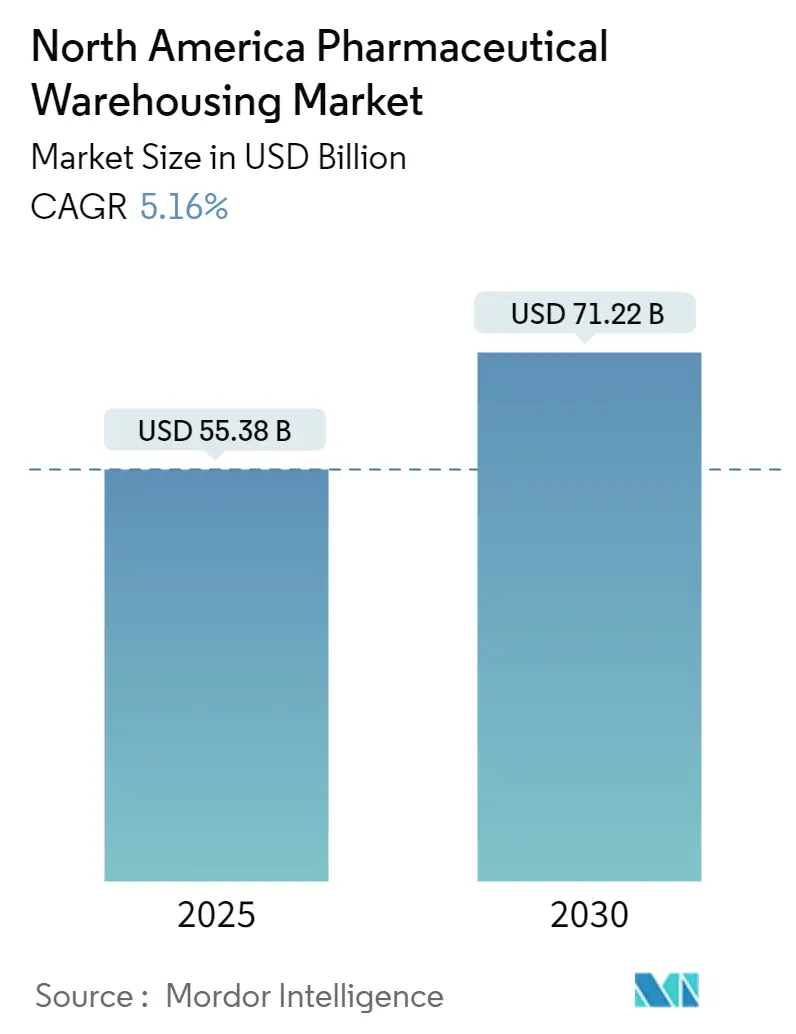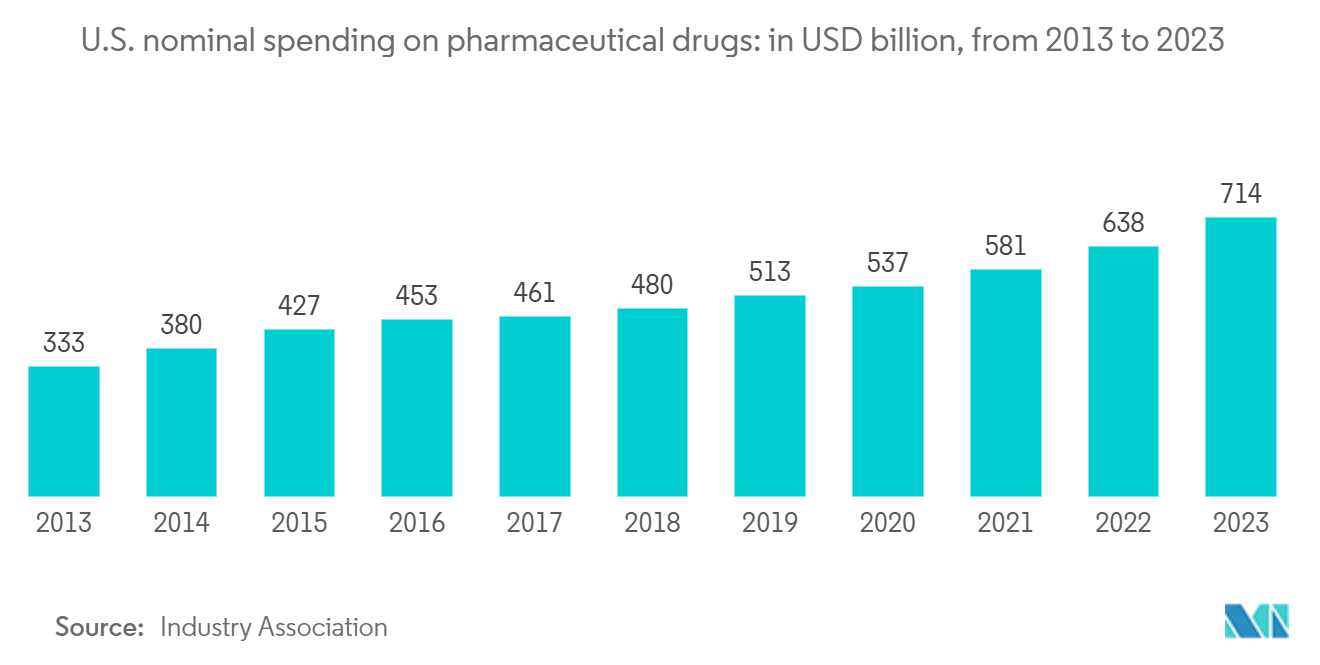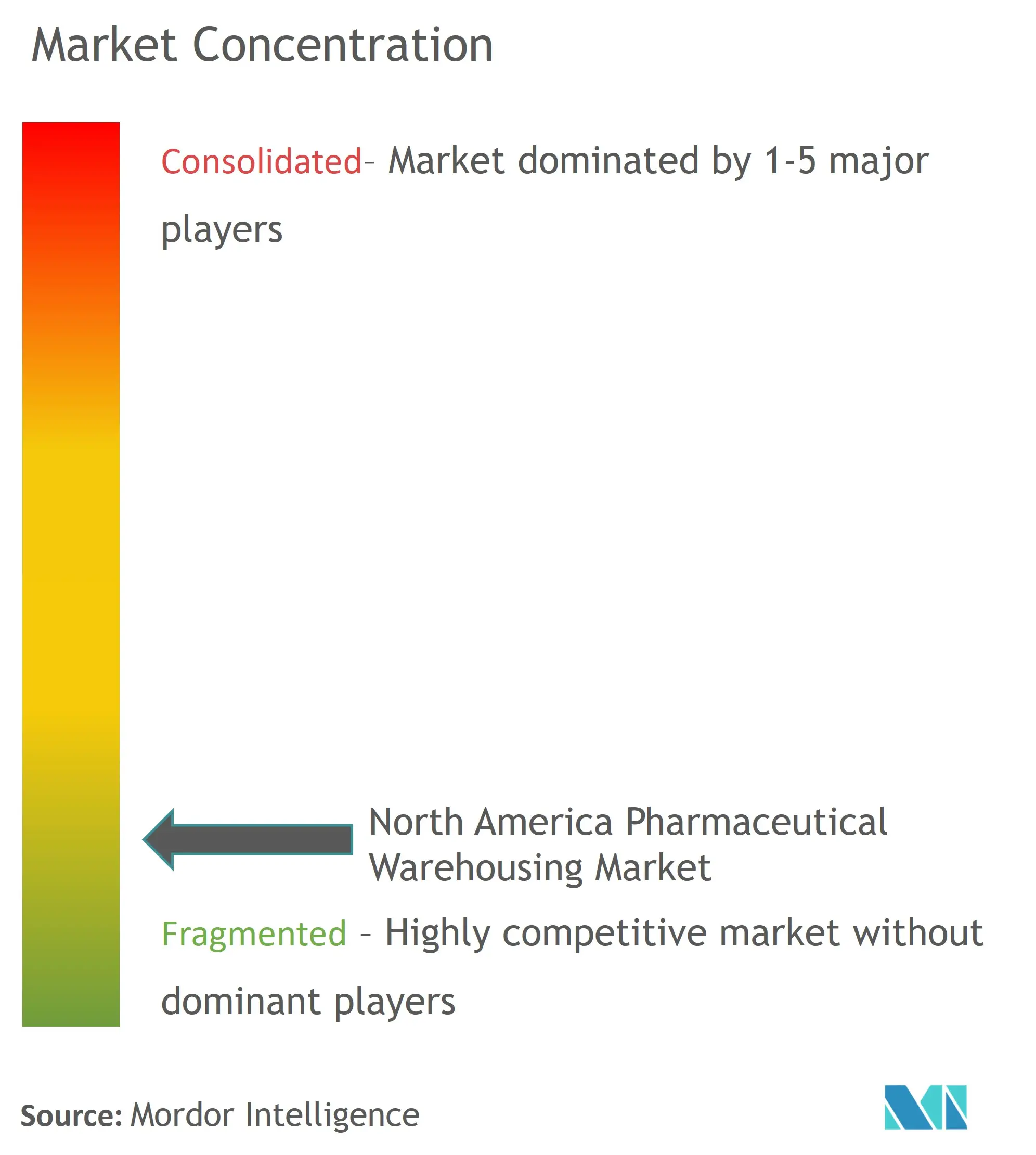North America Pharmaceutical Warehousing Market Size and Share

North America Pharmaceutical Warehousing Market Analysis by Mordor Intelligence
The North America Pharmaceutical Warehousing Market size is estimated at USD 55.38 billion in 2025, and is expected to reach USD 71.22 billion by 2030, at a CAGR of 5.16% during the forecast period (2025-2030).
The North American pharmaceutical warehousing market plays a pivotal role in the healthcare supply chain, influenced by stringent regulatory mandates and the evolving intricacies of pharmaceutical products. The U.S. Food and Drug Administration (FDA) enforces Good Manufacturing Practices (GMP), emphasizing strict temperature controls, efficient stock rotation, and robust traceability systems to uphold pharmaceutical integrity. A September 2023 FDA report highlighted that over 80% of U.S. facilities storing vaccines and biologics were equipped with specialized cold-chain storage, underscoring the U.S.'s stature as a leading pharmaceutical manufacturer .
In the U.S., technological innovations are transforming pharmaceutical warehousing. Most large warehouses now standardize real-time monitoring for temperature and humidity, ensuring adherence to FDA guidelines. The International Trade Administration (ITA) reported in October 2023 that U.S. pharmaceutical exports, notably high-value biologics, hit USD 88 billion, underscoring the pressing demand for secure and compliant warehousing. Furthermore, blockchain technology is being harnessed to bolster traceability, particularly for oncology drugs and gene therapies necessitating ultra-low storage, often dipping below -70°C. Since April 2023, IBM's pilot program has integrated blockchain to monitor temperature-sensitive pharmaceuticals, ensuring secure handling and mitigating counterfeit risks.
Canada’s pharmaceutical warehousing market is witnessing notable growth, bolstered by Health Canada’s GMP regulations. Statistics Canada, in January 2024, noted a 12% year-on-year surge in demand for cold-chain solutions, spurred by rising biologics imports and a governmental push to bolster domestic vaccine production . With over 70% of Canada's pharmaceutical exports heading to the U.S. (USD 6.74 billion), cross-border trade underscores the necessity for seamless regulatory compliance. This uptick in demand for temperature-sensitive storage further cements Canada's expanding role in North America's pharmaceutical landscape.
North America Pharmaceutical Warehousing Market Trends and Insights
Cold Chain Warehousing Driving the Pharmaceutical Warehousing Market
Across North America, the surging demand for temperature-sensitive pharmaceuticals—ranging from vaccines and biologics to specialty drugs—is propelling the expansion of cold chain warehousing. Infrastructure enhancements, strategic acquisitions, and cutting-edge technologies highlight the pivotal role of cold chain logistics in safeguarding the safety and efficacy of these vital products.
In Canada, the National Vaccine Storage and Handling Guidelines for Immunization Providers, crafted in collaboration with the Canadian Nurses Coalition on Immunization, set stringent standards for vaccine storage. These guidelines detail essential criteria, such as temperature ranges, required equipment, and optimal practices for distribution and disposal. On the corporate side, UPS has bolstered its cold chain capabilities through the acquisition of Frigo-Trans and its affiliate BPL. This move enriches UPS's suite of temperature-controlled packaging solutions, which now features reusable, eco-friendly options adept at catering to a spectrum of needs—from Controlled Room Temperature (15˚C to 25˚C) to Cryo (-160˚C).
DHL has tackled cost challenges in cold chain logistics by introducing cloud-based GPS-enabled sensors across ocean, rail, and truck freight. These sensors not only offer real-time temperature oversight but also enhance supply chain transparency, all while curbing operational expenses. Furthermore, in April 2024, Lineage Logistics unveiled a cross-border transportation service, bridging cold storage warehouses with markets in the U.S. and Canada. This move not only expands their reach but also weaves together comprehensive distribution networks in the region, catering to the escalating demand for fluid cold chain logistics.
Through the combined efforts of governmental bodies, industry leaders, and technological innovations, the significance of cold chain warehousing in North America's pharmaceutical landscape is being underscored, solidifying its role as a key catalyst for market growth.

U.S. Factory Warehousing Boosting Supply Chains
In 2024, the U.S. pharmaceutical supply chain is experiencing a notable upswing, fueled by strategic investments in factory warehousing and domestic manufacturing. A primary catalyst for this momentum is the U.S. government's concerted effort to diminish its dependence on overseas pharmaceutical production. To this end, the administration has earmarked funds to promote reshoring and establish Active Pharmaceutical Ingredient (API) manufacturing facilities. These initiatives are designed to bolster supply chain security, mitigate vulnerabilities, and foster a sustainable production framework.
Highlighting this trend, the Biden administration secured USD 7.5 billion in savings through a pact with pharmaceutical firms, capping prices on the ten priciest medications. This agreement, projected to slash net Medicare expenses by 22% (equating to USD 6 billion), underscores the government's pivotal role in redefining pharmaceutical supply chains and pricing dynamics. Furthermore, in June 2024, Novo Nordisk committed USD 4.1 billion to a new manufacturing plant in North Carolina, dedicated to producing the sought-after weight-loss medication, Ozempic. This facility is poised to amplify production capacity and fortify the supply chain, significantly bolstering the U.S.'s capability to cater to surging pharmaceutical demands, particularly for in-demand products.
Moreover, the U.S. is doubling down on its API production, with multiple initiatives focused on repatriating essential manufacturing. The API Innovation Center, a pivotal collaboration, is augmenting production in locales like St. Louis, generating employment and enhancing the nation's self-sufficiency in pharmaceuticals. This reshoring endeavor not only seeks to curtail reliance on global suppliers but also aims to empower the U.S. pharmaceutical supply chain to adeptly navigate future challenges.

Competitive Landscape
The market is highly fragmented due to the presence of a large number of international and local pharma logistics companies. These companies are competing fiercely to provide secure supply chain functions as well as cloud-based solutions. Furthermore, the ever-changing nature of pharmaceutical products keeps manufacturers focused on expanding their product range. Several large pharma logistics companies are teaming up to extend their reach and pool their expertise. Big companies are acquiring new technologies and know-how, while smaller vendors are getting the financial and infrastructure support they need.
Some of the major players include Deutsche Post DHL, FedEx Corporation, UPS Healthcare, C.H. Robinson, American Airlines Cargo, McKesson Corporation, etc. Major players in the market are implementing various strategies, such as strategic alliances, partnerships, mergers and acquisitions, geographical expansion, and product/service launches, to remain competitive in the market.
For instance, in September 2022, DHL Supply Chain acquired NTA (New Transport Applications), a company specializing in providing logistics services to the pharmaceutical and healthcare sectors. With more than 20 years of experience in the Mexican market, NTA is a recognized industry player serving more than 80 customers with services, including the storage and transportation of products that require refrigeration and temperature control.
North America Pharmaceutical Warehousing Industry Leaders
McKesson Corporation
Cardinal Health
AmerisourceBergen Corp
Langham Logistics
UPS Healthcare
- *Disclaimer: Major Players sorted in no particular order

Recent Industry Developments
- July 2024: In Mexico, the pharmaceutical logistics landscape has undergone a significant transformation, driven by the adoption of advanced technologies such as sensors, transparent digital records, and the Internet of Things (IoT). Every stage of the logistics process, from storage to the final distribution to pharmacies, clinics, and hospitals, has been optimized.
- December 2023: Andrés Manuel López Obrador, the former president of Mexico, inaugurated a vast "super pharmacy" - a sprawling 40,000 square meter (430,000 square foot) warehouse situated on the outskirts of Mexico City. This facility is designed to centralize supplies and distribute them to hospitals across the nation, complementing local health services.
North America Pharmaceutical Warehousing Market Report Scope
Pharmaceutical warehousing refers to the systematic storage of medicinal products and related items. It is used in the pharmaceutical industry to store active ingredients and other volatile substances that need to be stored in a controlled environment to be safe and effective.
The report provides a comprehensive background analysis of the North America Pharmaceutical Warehousing Market, covering the current market trends, market dynamics, technological updates, and detailed information on various segments and the industry’s competitive landscape.
The North America pharmaceutical Warehousing Market is segmented by type (cold chain warehouses and non-cold chain warehouses), application (pharmaceutical factory, pharmacy, hospital, and others), and country (United States, Canada, and Mexico). The report offers market size and forecasts for the North American pharmaceutical Warehousing Market in value (USD) for all the above segments.
| Cold Chain Warehouses |
| Non-Cold Chain Warehouses |
| Pharmaceutical Factory |
| Pharmacy |
| Hospital |
| Others |
| United States |
| Canada |
| Mexico |
| By Type | Cold Chain Warehouses |
| Non-Cold Chain Warehouses | |
| By Application | Pharmaceutical Factory |
| Pharmacy | |
| Hospital | |
| Others | |
| By Geography | United States |
| Canada | |
| Mexico |
Key Questions Answered in the Report
How big is the North America Pharmaceutical Warehousing Market?
The North America Pharmaceutical Warehousing Market size is expected to reach USD 55.38 billion in 2025 and grow at a CAGR of 5.16% to reach USD 71.22 billion by 2030.
What is the current North America Pharmaceutical Warehousing Market size?
In 2025, the North America Pharmaceutical Warehousing Market size is expected to reach USD 55.38 billion.
Who are the key players in North America Pharmaceutical Warehousing Market?
McKesson Corporation, Cardinal Health, AmerisourceBergen Corp, Langham Logistics and UPS Healthcare are the major companies operating in the North America Pharmaceutical Warehousing Market.
What years does this North America Pharmaceutical Warehousing Market cover, and what was the market size in 2024?
In 2024, the North America Pharmaceutical Warehousing Market size was estimated at USD 52.52 billion. The report covers the North America Pharmaceutical Warehousing Market historical market size for years: 2019, 2020, 2021, 2022, 2023 and 2024. The report also forecasts the North America Pharmaceutical Warehousing Market size for years: 2025, 2026, 2027, 2028, 2029 and 2030.
Page last updated on:
North America Pharmaceutical Warehousing Market Report
Statistics for the 2025 North America Pharmaceutical Warehousing market share, size and revenue growth rate, created by Mordor Intelligence™ Industry Reports. North America Pharmaceutical Warehousing analysis includes a market forecast outlook for 2025 to 2030 and historical overview. Get a sample of this industry analysis as a free report PDF download.



